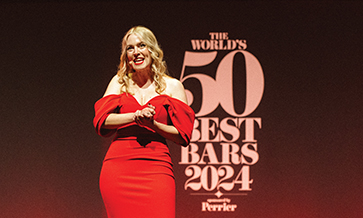Struan Grant Ralph, global brand ambassador for Glenfiddich met with Vikram Achanta, Consulting Editor for Brews & Spirits, at The Oberoi, New Delhi. A previous evening, had been spent pleasurably with Struan when he revealed what he called two “suitcase specials”, exclusive Glenfiddich variants, which we had the rare privilege to taste, one a peated version and the other which had been finished in Mizunara oak casks.
Does a brand ambassador have a responsibility for sales?
I’ve been with Glenfiddich for 8 years now. My journey started on the production side. I first worked in a couple of small distilleries in the Speyside region before joining Glenfiddich. Originally I was a local ambassador based out of South-East Asia, like Angad Bedi is in India.
An ambassador’s role is to bring the distillery to life for people who can’t visit it, via storytelling, by hosting tastings, education and mentoring. We have ambassadors in over 20 countries, and a part of my role is to make sure that they’re empowered and engaged to do their job. I also sit on the New Product Development team.
If the ambassador is executing his strategy in the right way, then it naturally has a commercial benefit. Most of our ambassadors don’t have a sales target and are encouraged to build a network. It does, however, depend on the country – some countries are quite commercially focused.
What would be your advice to someone who aspires to become a brand ambassador?
It’s a broad range of skills that you need; and it almost doesn’t matter what industry you’re coming from. My team has 31 ambassadors and I have people who’ve previously been tailors, lawyers, actors, singers and bartenders!
What matters is if you have a passion for whisky and if you have an ability to bring it to life, maybe in a new and innovative way. So, my one piece of advice would be to follow that passion and educate yourself as much as you can.
Also, build your network of people in the industry. An ambassador’s success is measured by who you have in your sphere of influence.
The best and most challenging part is the travel. I’ve been to 81 countries and had pretty incredible opportunities to see the world and that too with Glenfiddich, which is an incredibly popular whisky. I travel more than half the year, which is exhausting. But I celebrated Holi yesterday in New Delhi, and that was a dream come true!
What’s the one key message that you would always convey about William Grant and Sons?
We’re most proud of a few things – independence, family ownership, innovation and experimentation. Glenfiddich is the world’s most awarded single malt whisky and has an incredible set of people who make it.
Our people are the most important stories, from William Grant as the founder, to the people who are working there right now. I think human stories resonate the most. You can learn about flavour and process from a book, but to make great whisky you need great people.
For the Grant’s family members you have to work in the distillery for 4 years across every single area. I had guests coming around Glenfiddich last year and I was saying hello to a couple of mash men. There was one guy I didn’t recognise because he had his back to me. When he turned around I saw it was Glen Gordon, the current Chairman of the business – he was working on a Thursday night at 8:30 pm.
What’s the biggest whisky myth you’ve come across?
It doesn’t have to be as serious as it’s made out to be. Whisky should be fun and sociable, and we should break down the fact that it’s a male dominated industry. I work on a team that has mostly women; and the distillery too has a decent split of sexes.
What’s the most overblown trend at the moment in single malt? And the most under-reported one?
For a while the industry went too extreme on peat and strength. I think there was a trend of producing whiskies that were not that balanced. When people sit down and taste whiskies with us, they say they didn’t expect it to be smooth like this.
There’s a nice trend towards terroir conversations, so people are talking about provenance, where the barley is grown, what the temperature was like in the summer, the drainage, minerality and pH level of the water.
We take our water through granite and quartz, so it’s already arriving incredibly pure and naturally filtered through rock. Other under-reported trends are probably single malt cocktails and possibly the environmental impact of whisky making.
Whisky makers are going to town with newer types of casks for finishing whiskies. Do you think there’s anything left to be done?
In order to use a particular kind of cask, we have to show a precedent to the Scotch Whisky Association, that the cask we are using has a tradition in whisky making. Using casks which have previously been used for wine, sherry, port, etc. is relatively easy.
But for products like mezcal, tequila and absinthe, it’s really hard to try and get those for use in the whisky industry. In the Scotch whisky industry you have to use oak, whereas in the Irish and Canadian whisky industries you can use other kinds of wood. We feel, however, that oak gives you the best flavour.
We’re not done yet when it comes to casks and we do have a few interesting things up our sleeve. As an experiment we recently used Mizunara casks from Japan for finishing our whisky. It is very rare to find in Scotland and we’re very happy with the results. We may do something with that in the future.
What do you see as a challenge to Scotch whisky?
Well, Japanese whisky had us for a while, but they haven’t been able to manage their stocks well. Also, possibly people aren’t drinking as much as they used to, but of course people are also drinking better, and some of our more expensive variants.
How would you like to see your whisky being served by a bartender?
Our signature serve, say for Glenfiddich 12, is a highball. It’s a great drink to settle your palate before you start your evening.
Since single malt is pretty expensive what would you recommend for bar owners to move more?
Giving the education and the confidence to your bar staff, to enable them to upsell, is the key. We’ve seen that tasting flights work well. Say 15-20 ml each of a 15-yo, 18-yo and 21-yo. So you’re tasting a 21-year-old, but a small measure. The next time you come in, you might well decide to order just that.
What’s your desert island dram?
Glenfiddich 12 highball!
Single malt cocktails: Yes or No?
I’d recommend a Manhattan or an Old Fashioned, made with a Glenfiddich 15-year-old. With a spirit as fine as Glenfiddich, we’d also expect that all the other ingredients also complement it, be it the quality of the ice, the Vermouth, etc.
– You can follow Struan on Instagram at the_whisky_beard or on Twitter at TheWhisky_beard














